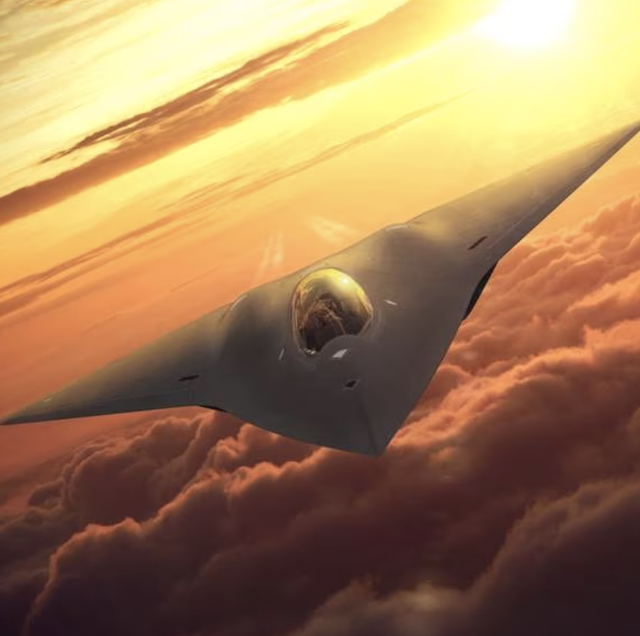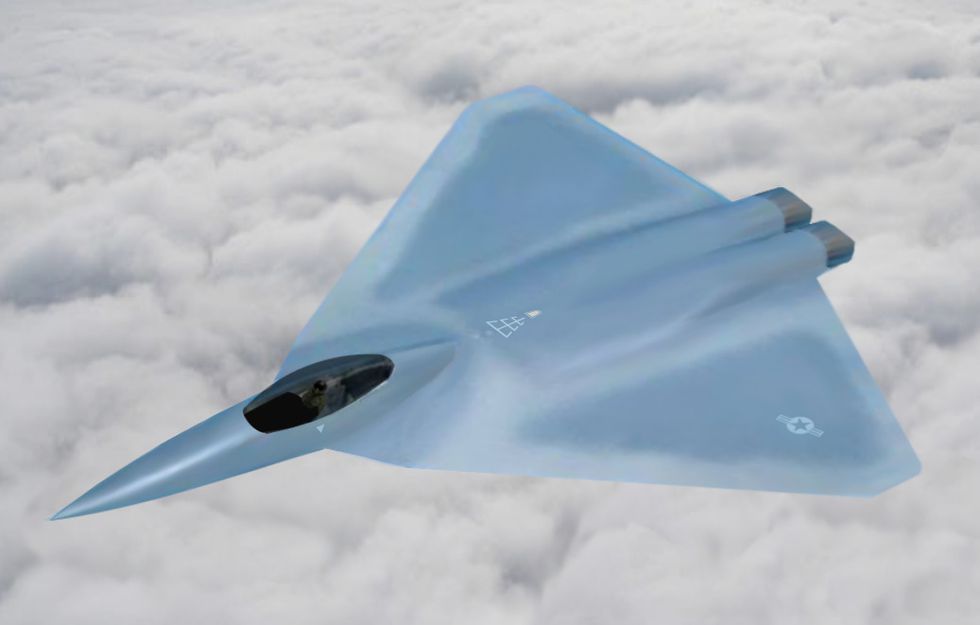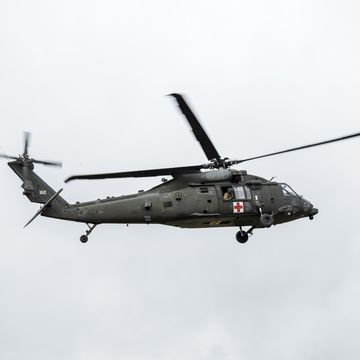- Leaked images reveal a tailless design for China’s sixth-generation stealth fighter jet.
- The fighter has several similarities to the U.S. Air Force’s secret sixth-generation fighter jet.
- China’s and the U.S.’s stealth fighters each have their distinct advantages.
China’s military aviation industry has been releasing more and more concept art for a future stealth fighter on social media. While such computer-rendered designs are anything but finalized, one thing seems clear: the future for China’s sixth-generation stealth fighter is likely a tailless one—just as appears to be the case for America’s own Next Generation Air Dominance (NGAD) stealth fighter.
On January 31, 2023, the Aviation Industry Corporation of China (AVIC) posted a video featuring CGI concept art of a notional sixth-generation stealth fighter. The twin-engine jet fighters portrayed had low-reflective diamond-shaped wings like Northrop-Grumman’s promising YF-23 Black Widow demonstrator fighter, a blended-wing body configuration—and no tail.
Another video shared by AVIC on Weibo on Tuesday reveals a tailless, stealth-optimized airframe undergoing testing in the FL-3 high-speed wind tunnel.
Other signs and portents abound. Earlier on January 18, a photo of a tailless fighter on a computer monitor—apparently at the Shanghai-based China Aeronautical Radio Electronic Research Institute—circulated on Weibo.
The aircraft on the monitor seemingly correspond to a mysterious tailless demonstrator or mockup spotted in a satellite photo of Chengdu Aircraft Corporation (CAC) factory in October 2021. CAC manufactures China’s J-20 fifth-generation stealth fighter.
Meanwhile, in November 2022, a tailless fighter mockup was displayed at the Zhuhai airshow.
Such artwork and mockups should only be interpreted in the broadest of strokes at this stage. Many conceptual designs don’t make it to production, and those that do inevitably undergo substantial revision.
Indeed, Lockheed-Martin’s concept work on a tailless manned fighter testbed called the X-44 MANTA (for Multi-Axis No-Tail Aircraft) was never realized, except perhaps in the form of tailless drone demonstrator also called the X-44.
Rick Joe, who writes many in-depth pieces on Chinese military technology and force structure, commented on social media that art of a “generic ‘tailless large future fighter’… is ‘significant’ only in the sense that AVIC wouldn’t show a high profile CGI if they weren't working on a meaningful next-gen fighter. The details probably aren’t important so much as ‘stealthy tailless fighter’ is something they're conformable signaling.”
Broadly speaking, the forthcoming sixth-generation of jet fighters is expected to again emphasize stealthy airframes like the fifth-generation, but built for greater range and payload reflecting the geographic realities of a potential U.S.-China conflict across the western Pacific ocean.
Expected new capabilities include AI piloting assistance, drone-control capabilities, even more extensive networking of sensors with friendly forces than is found on the very networkable F-35, and flexible combined cycle engines capable of sustained supersonic cruising while generating enough electricity for powerful jammers or directed-energy weapons like lasers.
The U.S. Air Force’s forthcoming NGAD fighter already exists as a flying demonstrator, but has yet to be revealed to the public. However, recently published concept art suggests a large triangular flying wing comparable to a steel-skinned Dorito when seen from above. In theory, the manned NGAD fighter will be built alongside supporting drones and ground platforms (a “system of systems”) it cooperates with to perform its missions.
While China has a history of industrial espionage and reverse-engineering imported combat aircraft and helicopters, its apparent inclination for a tailless design likely reflects convergence on similar obvious technological solutions rather than ‘stealing’ per se.
Tail fins, or horizontal and vertical stabilizers, impart both stability and expanded maneuverability options to aircraft. That’s traditionally important for fighter aircraft designed to outmaneuver adversaries in Within-Visual Range combat. The vertical stabilizer or rudder enables sideways yawing movement (and helps counter-act such movement from crosswinds) while horizontal stabilizers help pitch the aircraft up or down.
But reflective surfaces on stabilizers also complicate and limit attempts to reduce a warplane’s radar cross-section, particularly when scanned from behind or the side. For this reason, “flying wings” without stabilizers feature in the U.S.’s B-2 Spirit stealth bomber and stealthy drones like the RQ-170. Removing stabilizers also reduces weight and drag, increasing range and sustainable cruising speed.
Tailless aircraft typically rely on computer-assisted fly-by-wire systems to manipulate the flaps in the wings for maneuvering and compensate for reduced stability. An article in China’s Global Times implies split-brake flaps and thrust vectoring engines (which have moveable exhaust nozzles) may also be harnessed to provide an additional maneuvering mechanism. China has devoted efforts to developing and testing indigenous thrust-vector control engines on single-engine J-10 and twin-engine J-20 fighters, though it doesn’t appear to be a standardized feature yet in its domestically-build warplanes.
While these methods may not fully restore maneuverability options afforded by stabilizers, the U.S. Air Force and China both seem to agree that future aerial warfare will be primarily fought and won in beyond visual range (BVR) combat. By that premise, the benefits of greater stealth outweigh the loss of maneuverability.
When it comes to air-to-air combat, the U.S. still has a lead in stealth technology and vastly more mature engine-manufacturing capability. But in one respect, China has a leg up due to fielding the longer-range PL-15 and PL-21 missiles, while production of longer-reaching AIM-260 missiles isn’t due until 2026. Modern Chinese fighters, unlike Russian ones, also boast jam-resistant and stealthy AESA radars, though their level of capability compared to the more mature AESA radars in U.S. fighters is unclear.
A recent series of wargames by the CSIS think tank simulating an attempted invasion of Taiwan in 2026 found that U.S. bombers launching missiles hundreds of miles east of the island could sustainably inflict massive damage to the People’s Liberation Army Navy. Therefore, the PLA Air Force likely wants stealthy long-range fighters that can slip past air defenses and fighter patrols near Taiwan to harry the U.S. bombers flinging long-range missiles from backfield.
Meanwhile, the U.S. Air Force wants NGAD to have the extended range (1,000+ nautical miles) needed to escort those bombers across the Pacific Ocean operating from bases outside the reach of the majority of China’s powerful ballistic missiles. Thus it’s no surprise both air forces are apparently pursuing broadly similar sixth-generation fighter concepts.
Sébastien Roblin has written on the technical, historical, and political aspects of international security and conflict for publications including 19FortyFive, The National Interest, MSNBC, Forbes.com, Inside Unmanned Systems and War is Boring. He holds a Master’s degree from Georgetown University and served with the Peace Corps in China. You can follow his articles on Twitter.














